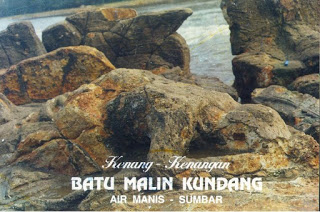"Once upon a time, there was a beautiful princess..." That kind of sentence can be found easily when we read stories and tales like Cinderella, Rapunzel, or Little Red Riding Hood. It might look a little bit silly right now, but when we were small children, I am sure that you were amused to hear such stories. In our English lesson in junior high school (SMP), a story that is told in order to amuse or to entertain its readers is considered as a narrative text. Legends, myths, and folklores like the legends of Jaka Tarub, Nyi Roro Kidul or Malin Kundang can also categorized into this group. A narrative text is usually told in past tenses. It might be simple, perfect, or perfect continuous tense. It is similar with recount text, the different is most narrative texts are fictional, while recount texts are based on real life events. In this article, we will discuss narrative text using the legend of Malin Kundang as an example. This legend is very famous in Indonesia, the moral of the story is that children must respect their parents no matter how bad their condition is. On the shore of Air Manis, West Sumatra, we can see a rock which is said to be the petrified disrespectful child, Malin Kundang. A narrative text usually consists of three parts, such as: Orientation In this part, the writer tells the reader about characters and settings of the story. It might be quite descriptive like how the characters look, how they interact with people, how the situation of the characters' neighbourhood, in what area it is located, etc. Let see an example we have from the story of Malin Kundang below: A long time ago, in a small village near the beach in West Sumatra, a woman and her son lived. They were Malin Kundang and her mother. Her mother was a single parent because Malin Kundang's father had passed away when he was a baby. Malin Kundang had to live hard with his mother. Malin Kundang was a healthy, dilligent, and strong boy. He usually went to sea to catch fish. After getting fish he would bring it to his mother, or sold the caught fish in the town. Complication This part shows the main character starts to find his / her problems or challenges. In other words, this is the part where the story starts to flow. The tension will increase until it reaches a point where the main event of the story, something that we call climax in dramas. For example: One day, when Malin Kundang was sailing, he saw a merchant's ship which was being raided by a small band of pirates. He helped the merchant. With his brave and power, Malin Kundang defeated the pirates. The merchant was so happy and thanked to him. In return the merchant asked Malin Kundang to sail with him. To get a better life, Malin Kundang agreed. He left his mother alone. Many years later, Malin Kundang became wealthy. He had a huge ship and was helped by many ship crews loading trading goods. Perfectly he had a beautiful wife too. When he was sailing his trading journey, his ship landed on a beach near a small village. The villagers recognized him. The news ran fast in the town; “Malin Kundang has become rich and now he is here”. An old woman ran to the beach to meet the new rich merchant. She was Malin Kundang’s mother. She wanted to hug him, released her sadness of being lonely after so long time. Unfortunately, when the mother came, Malin Kundang who was in front of his well dressed wife and his ship crews denied meeting that old lonely woman. For three times her mother begged Malin Kundang and for three times he yelled at her. At last Malin Kundang said to her "Enough, old woman! I have never had a mother like you, a dirty and ugly woman!" After that he ordered his crews to set sail. He would leave the old mother again but in that time she was full of both sadness and angriness. Finally, enraged, she cursed Malin Kundang that he would turn into a stone if he didn't apologize. Malin Kundang just laughed and really set sail. Resolution This is where the problems are solved, either for better or worse. So, it means the story does not have to end happily. This is the example of resolution of Malin Kundang story: In the quiet sea, suddenly a thunderstorm came. His huge ship was wrecked and it was too late for Malin Kundang to apologize. He was thrown by the wave out of his ship. He fell on a small island. It was really too late for him to avoid his curse. Suddenly, he turned into a stone. Some writers also add parts like evaluation and reorientation to their narrative texts. Evaluation is the part where the writer evaluates what have happened to the main character. Reorientation is a part after resolution which tells what happens aftermath. However, these two parts (evaluation and reorientation) are additional. OK then, that was a simple explanation about narrative text, I hope it can be helpful for you, fellows. Enjoy! Source of Malin Kundang Story: Click HERE










